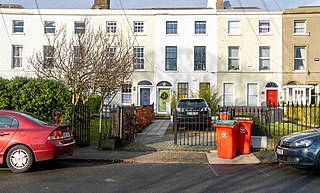
Glasnevin is a neighbourhood of Dublin, Ireland, situated on the River Tolka. While primarily residential, Glasnevin is also home to the National Botanic Gardens, Glasnevin Cemetery, the National Meteorological Office, and a range of other state bodies, and Dublin City University has its main campus and other facilities in and near the area. Glasnevin is also a civil parish in the ancient barony of Coolock.

Donnybrook is a district of Dublin, Ireland, on the southside of the city, in the Dublin 4 postal district. It is home to the Irish public service broadcaster Raidió Teilifís Éireann (RTÉ) and was once part of the Pembroke Township. Its neighbouring suburbs are Ballsbridge, Sandymount, Ranelagh and Clonskeagh.

Dublin City University is a university based on the Northside of Dublin, Ireland. Created as the National Institute for Higher Education, Dublin in 1975, it enrolled its first students in 1980, and was elevated to university status in September 1989 by statute.

St Patrick's College, often known as St Pat's, was a third level institution in Ireland, the leading function of which was as the country's largest primary teacher training college, which had at one time up to 2,000 students. Founded in Drumcondra, in the northern suburbs of Dublin, in 1875, with a Roman Catholic ethos, it offered a number of undergraduate courses, primarily in primary education and arts, and in time postgraduate courses too, mostly in education and languages.

All Hallows College was a college of higher education in Dublin. It was founded in 1842 and was run by the Vincentians from 1892 until 2016. On 23 May 2014, it was announced that it was closing because of declining student enrollment. The sale of the campus in Drumcondra to Dublin City University was announced on 19 June 2015 and completed on 8 April 2016. The college closed on 30 November 2016, becoming the All Hallows Campus of Dublin City University.

Drumcondra is a residential area and inner suburb on the Northside of Dublin, Ireland. It is administered by Dublin City Council. The River Tolka and the Royal Canal flow through the area.

Nevill Josiah Aylmer Coghill VC was a British Army officer and recipient of the Victoria Cross, the highest and most prestigious award for gallantry in the face of the enemy that can be awarded to British and Commonwealth forces.

Fairview is an inner coastal suburb of Dublin in Ireland, in the jurisdiction of Dublin City Council and in the city's D03 postal district. Part of the area forms Fairview Park, a recreational amenity laid out on land reclaimed from the sea.

Clonliffe is an area on the Northside of Dublin, Ireland, between Ballybough and Drumcondra in the Dublin 3 postal district.

Marino is an inner suburb on the Northside of Dublin, Ireland. It was built, in a planned form, on former grounds of Marino House, in an area between Drumcondra, Donnycarney, Clontarf, and what became Fairview. The initial development featured around 1,300 concrete-built houses.

James Sadler was the first English balloonist, as well as a chemist and pastry chef.
Dublin City University Gaelic Athletic Association Club is the GAA club at Dublin City University. The club fields teams in men's Gaelic football, hurling, ladies' Gaelic football and camogie. It also organises Gaelic handball. The club mainly competes in intervarsity competitions such as the Sigerson Cup, the Fitzgibbon Cup, the O'Connor Cup and the Ashbourne Cup. DCU has also entered competitions organised by the Leinster GAA, including the O'Byrne Cup, the Kehoe Cup and Walsh Cup. In 2016 St. Patrick's College, Drumcondra merged with Dublin City University. As a result some DCU GAA teams, especially reserve teams, compete as DCU St Patrick's or DCU Dóchas Éireann.

Kilmacud is a suburban area of Dublin in Dún Laoghaire–Rathdown, Ireland, at least partly contiguous with Stillorgan.

Holy Cross College, located on Clonliffe Road, Drumcondra, was founded in 1854 as the Catholic diocesan seminary for Dublin by Paul Cullen, Archbishop of Dublin (later created, in 1866.

Drumcondra Church of Ireland is a Church of Ireland church located in Drumcondra, Dublin, previously in the Civil Parish of Clonturk. The church and its churchyard contain memorials to a number of notable historical figures.

The Ashbourne Cup is an Irish camogie tournament played each year to determine the national champion university or third level college. The Ashbourne Cup is the highest division in inter-collegiate camogie. The competition features many of the current stars of the game and is sometimes known as the 'Olympics of Camogie' because of the disproportionate number of All Star and All-Ireland elite level players who participate each year Since 1972 it has been administered by the Higher EducationArchived 31 May 2011 at the Wayback Machine committee of the Camogie Association. TU Dublin are the current champions, having won the Ashbourne cup in 2023.
Marmaduke Coghill (1673–1738) was a member of Parliament for Dublin University, judge of the Prerogative Court and Chancellor of the Exchequer of Ireland.

Drumcondra House is a Georgian house with gardens in Drumcondra, Dublin, Ireland which as of 2022 forms part of DCU's All Hallows Campus, having been part of All Hallows College. It was designed by the architects Sir Edward Lovett Pearce and Alessandro Galilei and was built in 1726 for Marmaduke Coghill, who had originally lived in Belvidere House, which now forms part of DCU's St Patrick's Campus.
Sir Robert Booth (1626–1681) was an English-born judge who had a highly successful career in Ireland, where he held the offices of Chief Justice of the Irish Common Pleas and Lord Chief Justice of the King's Bench in Ireland.

Daire Kilian Keogh is an academic historian and third-level educational leader, president of Dublin City University (DCU) since July 2020.



















